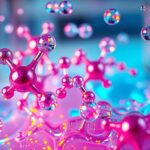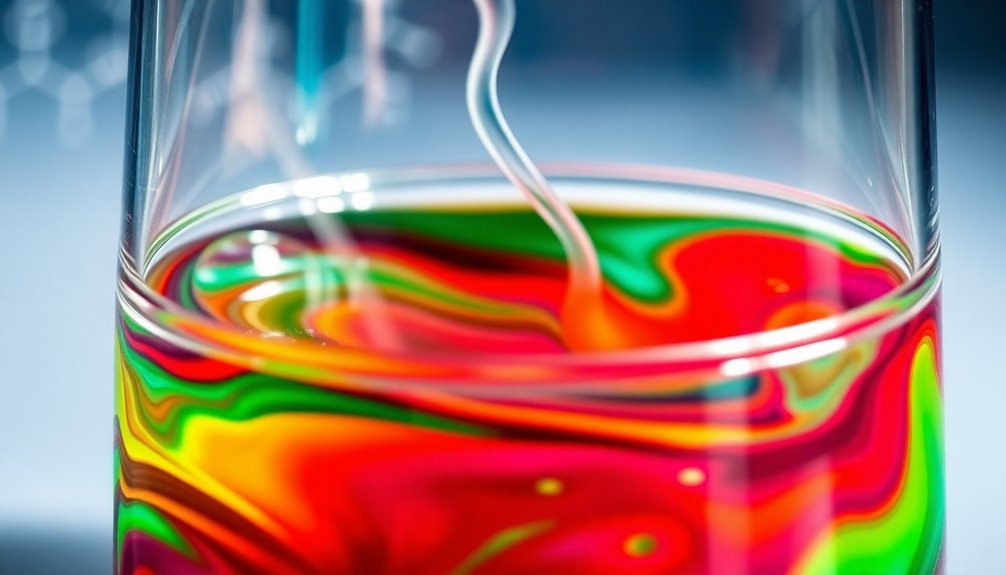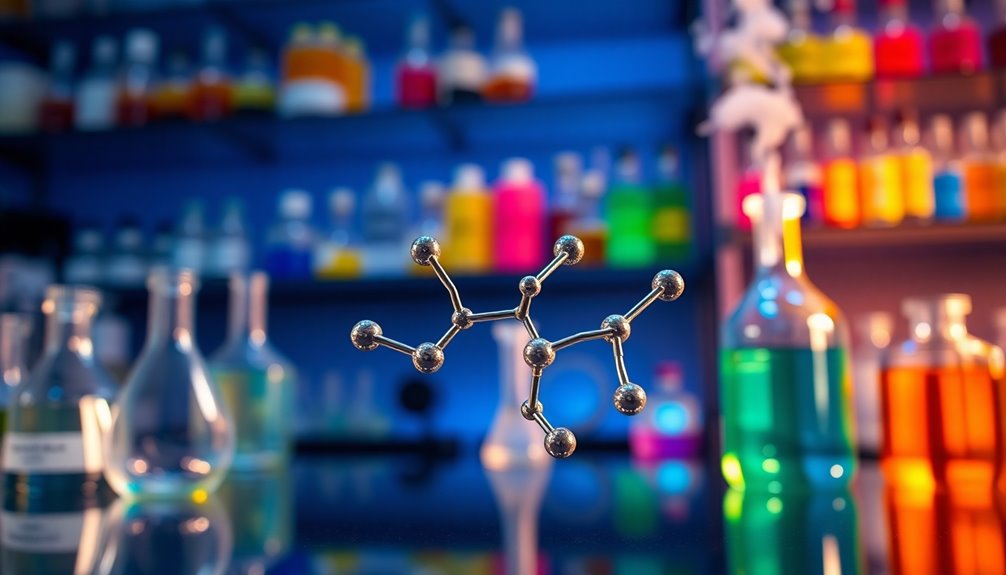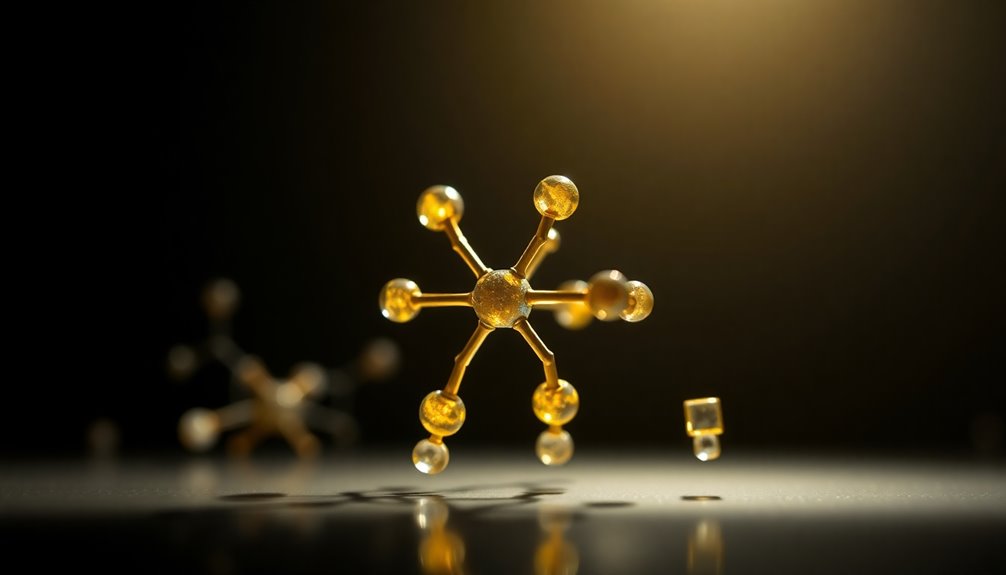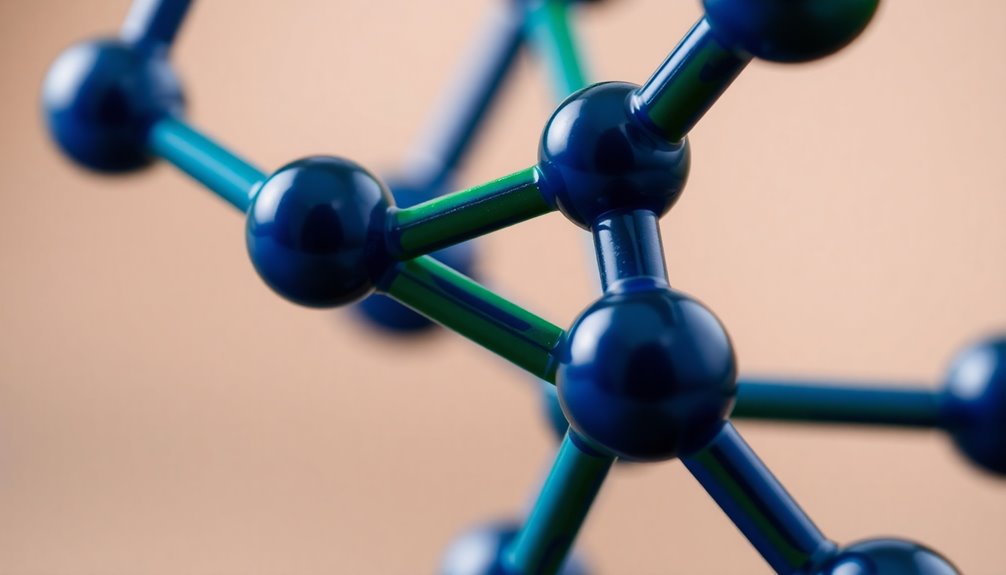Aromatic bonds are key in organic chemistry, featuring the delocalization of π electrons within cyclic, planar structures. You'll notice these bonds in compounds like benzene and toluene, where the electrons are shared across adjacent atoms. This sharing leads to increased stability and equal bond lengths, thanks to resonance. Aromatic compounds also follow Hückel's rule, requiring 4n + 2 π electrons for stability. They generally favor substitution reactions, making them unique in chemical behavior. If you're curious about their various types and applications, there's plenty more to explore about these fascinating compounds.
Key Takeaways
- Aromatic bonds involve delocalized π electrons in cyclic, planar structures, contributing to their stability and unique chemical properties.
- Compliance with Hückel's rule (4n + 2 π electrons) is essential for a compound to be classified as aromatic.
- Aromatic compounds exhibit equal bond lengths between single and double bonds due to resonance stabilization.
- They prefer substitution reactions over addition reactions, reflecting their enhanced stability.
- Common examples include benzene, toluene, and naphthalene, showcasing various types of aromatic compounds.
Definition of Aromatic Bonds
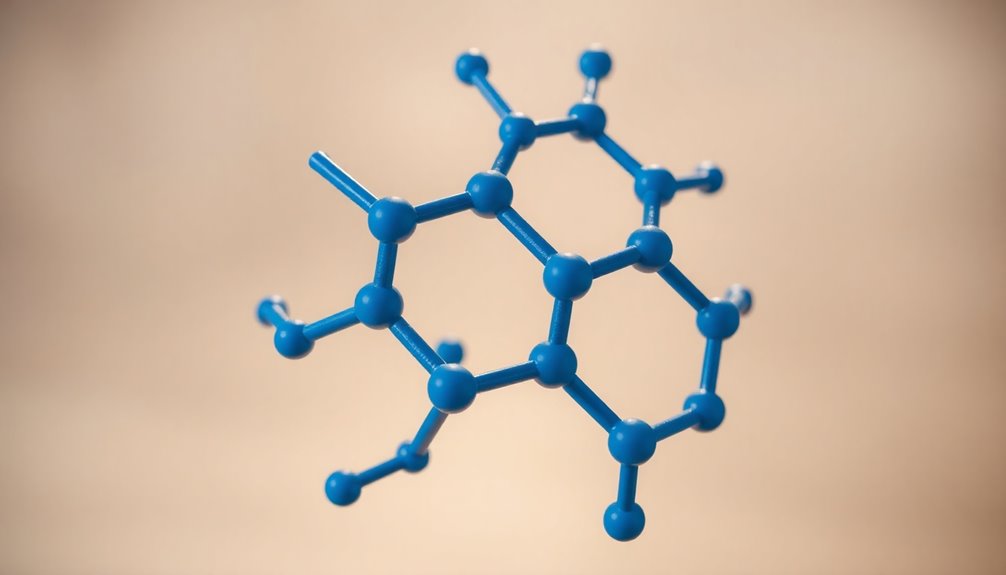
Aromatic bonds are a unique feature of aromatic compounds, where covalent bonds form through the delocalization of π electrons in a cyclic, planar structure.
These bonds result in equal bond lengths that sit between single and double bonds due to resonance stabilization. You'll find that aromatic bonds play a critical role in defining the chemical properties of these compounds.
According to Hückel's rule, an aromatic compound must possess a total of 4n + 2 π electrons, ensuring stability. This delocalization contributes to the overall stability of aromatic compounds, making them less reactive than non-aromatic counterparts.
Additionally, aromatic bonds extend to heterocycles, which include non-carbon atoms within the planar rings, showcasing the versatility of aromatic systems.
Characteristics of Aromatic Compounds
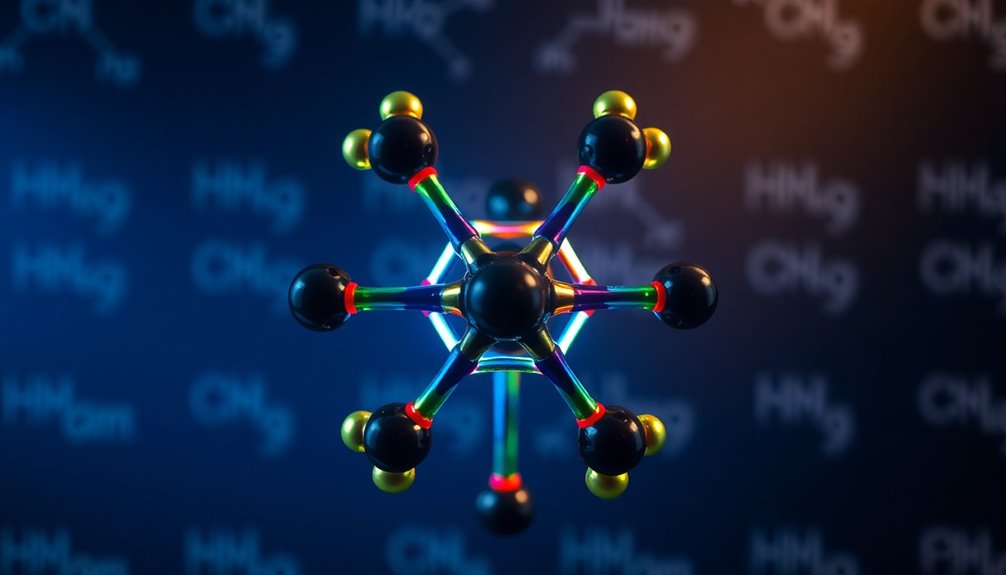
When you explore aromatic compounds, you'll notice their unique characteristics that set them apart.
Their planar structure allows for delocalized electron distribution, which plays a significant role in their stability.
Plus, they follow Hückel's rule, ensuring they've the right number of π electrons for aromaticity.
Delocalized Electron Distribution
Delocalized electron distribution is a defining feature of aromatic compounds, creating a unique stability that sets them apart from aliphatic ones. This stability arises from several key characteristics:
- Delocalized π electrons spread evenly across the cyclic structure.
- Resonance stabilization allows for equal bond lengths, intermediate between single and double bonds.
- According to Hückel's Rule, aromatic compounds must contain 4n + 2 π electrons, enhancing their stability.
- The even electron density above and below the ring contributes to aromaticity, making these compounds less reactive and favoring substitution reactions over addition reactions.
These features not only define aromatic compounds but also influence their unique chemical behavior in various reactions.
Planar Molecular Structure
The distinct planar structure of aromatic compounds plays an essential role in their unique properties and stability. Each carbon atom in an aromatic ring is sp² hybridized, ensuring a coplanar arrangement that allows for effective overlap of p orbitals.
This configuration facilitates a continuous loop of delocalized π electrons, contributing to the compound's resonance and overall stability. The equal bond lengths among carbon-carbon connections, typically around 1.39 Å in benzene, reflect this planarity and result in bond characteristics that are intermediate between single and double bonds.
Additionally, the planar molecular structure enhances reactivity, enabling aromatic compounds to undergo electrophilic substitution reactions while maintaining their aromatic stability.
This combination of features makes aromatic compounds particularly interesting in chemistry.
Hückel's Rule Compliance
To qualify as aromatic, a compound must adhere to Hückel's Rule, which dictates that it contains a closed loop of π electrons fitting the formula 4n + 2. This rule guarantees stability through delocalization, influencing chemical reactivity.
Here are the key characteristics of aromatic compounds:
- They've a total count of π electrons that satisfies Hückel's Rule (e.g., benzene has 6 π electrons, n=1).
- Planarity is essential, allowing for effective overlap of p orbitals.
- Examples include naphthalene, with 10 π electrons (n=2), showcasing stability.
- Non-aromatic compounds fail this criterion, affecting their stability and reactivity, such as cyclobutadiene, which is antiaromatic.
Understanding Hückel's Rule is vital for identifying aromatic compounds.
Historical Context of Aromaticity
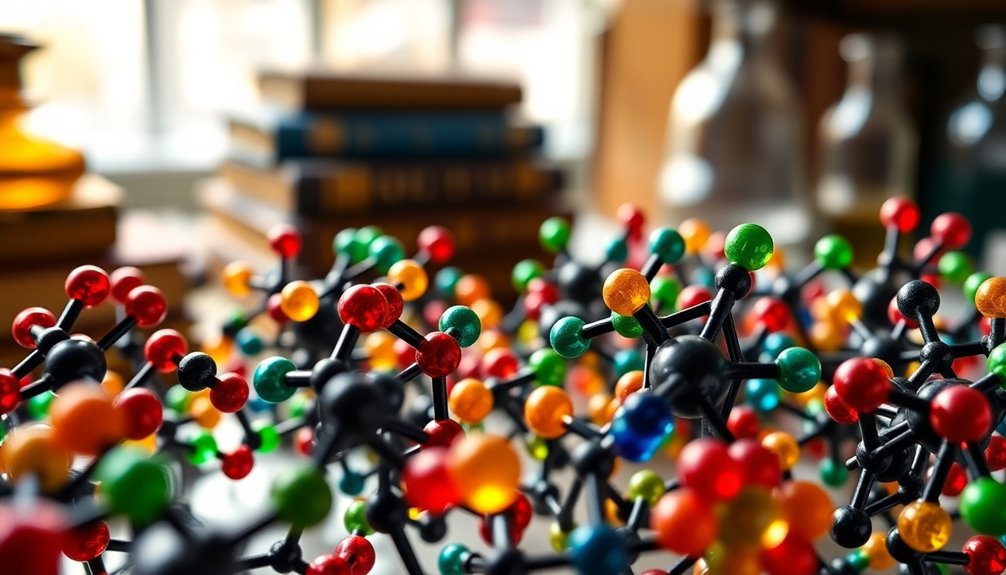
You might find it fascinating how the concept of aromaticity evolved over time, beginning with Hofmann's 1855 introduction of the term linked to scent.
As you explore the contributions of chemists like Kekulé and Thomson, you'll see how their insights shaped our understanding of benzene's unique structure and behavior.
These early theories laid the groundwork for the principles we study today in aromatic compounds.
Early Theories of Aromaticity
Although the term "aromatic" initially described compounds with pleasant odors, its meaning evolved considerably in the 19th century as chemists began to explore the structures of these unique compounds.
You'll find that early theories laid the groundwork for understanding aromaticity:
- August Kekulé proposed the cyclohexatriene structure for benzene in 1865, suggesting alternating single and double bonds.
- J. J. Thomson introduced the concept of electron delocalization, highlighting that electrons between carbon atoms are equivalent.
- In 1925, Sir Robert Robinson coined the term "aromatic sextet," emphasizing the stability provided by benzene's six π electrons.
- Researchers like Schleyer and Merino further refined the understanding of aromatic compounds and their implications in cyclic compounds.
These insights shifted the perception of aromaticity into a domain of stability and structure.
Key Historical Contributors
As chemists explored deeper into the nature of aromatic compounds, several key historical contributors emerged, shaping our understanding of aromaticity.
In 1855, August Wilhelm Hofmann first introduced the term "aromatic," linking chemical structure to odors.
Then, in 1865, August Kekulé proposed the cyclohexatriene structure for benzene, which clarified its unique bonding.
J.J. Thomson later suggested that all carbon atoms in benzene share equivalent electrons, highlighting electron delocalization within aromatic compounds.
In 1925, Sir Robert Robinson coined the term "aromatic sextet" to describe the stability of benzene through its six π electrons.
Further contributions from chemists like Schleyer and Merino advanced our grasp of delocalized pi systems in cyclic molecules, enhancing the overall understanding of aromaticity.
Types of Aromatic Compounds
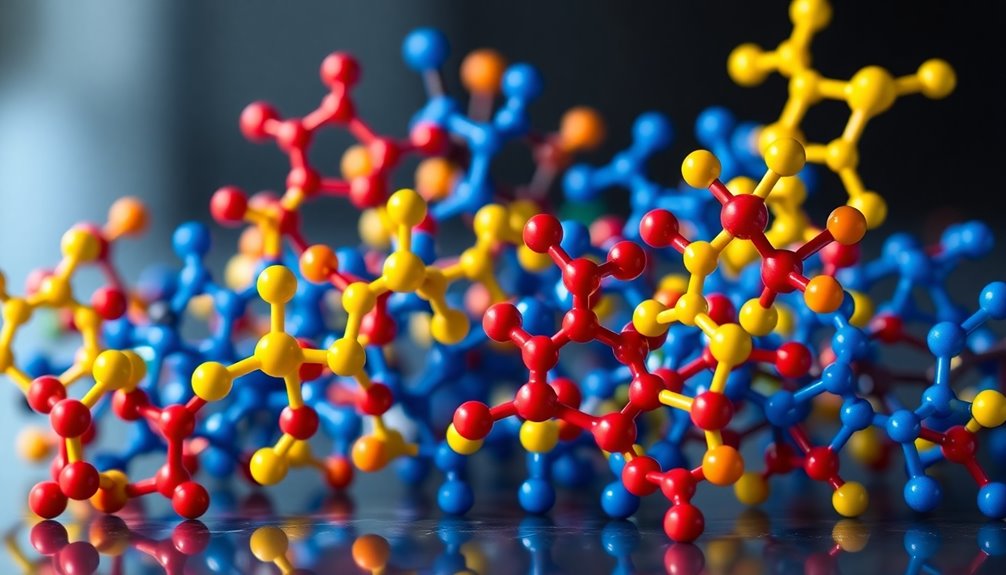
Aromatic compounds come in various types, each with distinct features and properties. Understanding these classifications can deepen your appreciation of their aromatic nature. Here are four main types:
- Monosubstituted aromatic hydrocarbons: Compounds like toluene showcase a single substituent on a benzene ring.
- Heterocyclic aromatic compounds: These include nitrogen, oxygen, or sulfur in the ring, with examples like pyridine and furan.
- Polycyclic aromatic hydrocarbons: Featuring multiple fused benzene rings, naphthalene is a prime example of structural complexity.
- Aromatic ions: Charged species like the cyclopropenyl cation illustrate that aromaticity extends beyond neutral molecules.
Additionally, annulenes, with alternating single and double bonds, further highlight the diversity within aromatic compounds.
Atypical Aromatic Compounds
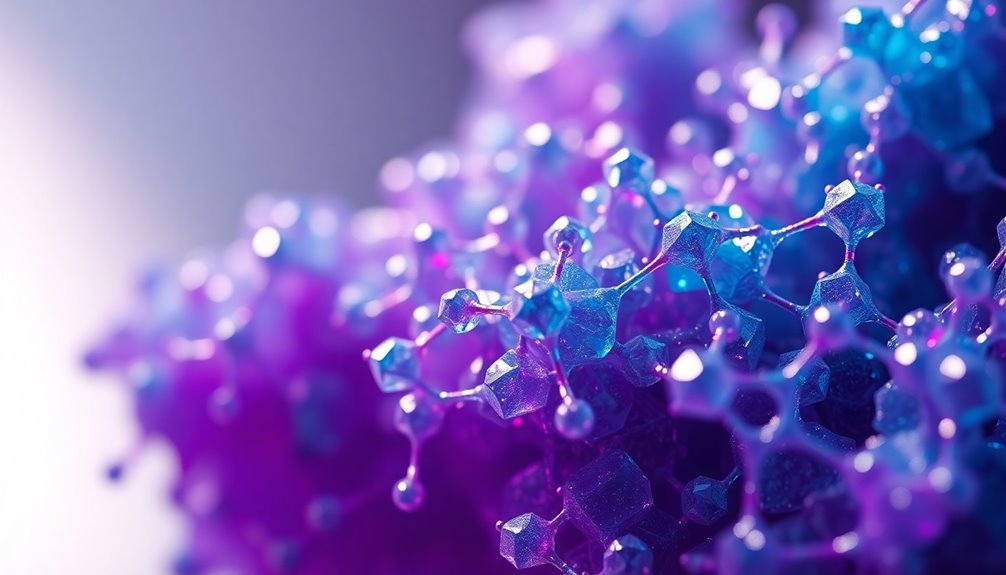
While many people think of aromatic compounds as primarily involving benzene, the world of atypical aromatic compounds reveals fascinating alternatives that challenge traditional definitions.
These include non-benzenoid structures like the cyclopropenyl cation and tropone, which still exhibit aromatic properties due to their π electron delocalization.
Homoaromaticity showcases compounds where conjugation is interrupted yet aromatic stability is maintained.
Additionally, borabenzene, silabenzene, and germanabenzene demonstrate that non-carbon-based cyclic structures can retain aromatic characteristics.
Möbius aromatic compounds, with their unique half-twist and 4n π electrons, further complicate our understanding of aromaticity.
Experimental evidence, such as Li NMR spectroscopy, confirms the aromatic nature of unusual cyclic molecules, expanding the definition of aromatic compounds beyond traditional hydrocarbons.
Applications of Aromatic Compounds

Exploring the diverse world of aromatic compounds reveals their significant applications across various industries. Here are four key areas where you'll find these compounds making an impact:
- Pharmaceutical Industry: Aromatic compounds serve as building blocks for essential drugs, like analgesics and anti-inflammatory medications.
- Chemical Manufacturing: Aromatic hydrocarbons, such as benzene, toluene, and xylene, are crucial solvents and intermediates for producing plastics, dyes, and synthetic fibers.
- Agrochemicals: Many herbicides and pesticides leverage aromatic structures to improve efficacy and stability.
- Advanced Materials: Their unique properties make aromatic compounds ideal for developing polymers and nanomaterials used in electronics and coatings.
Aromatic compounds also play a role in environmental chemistry, aiding pollution management and bioremediation strategies.
Importance in Organic Chemistry
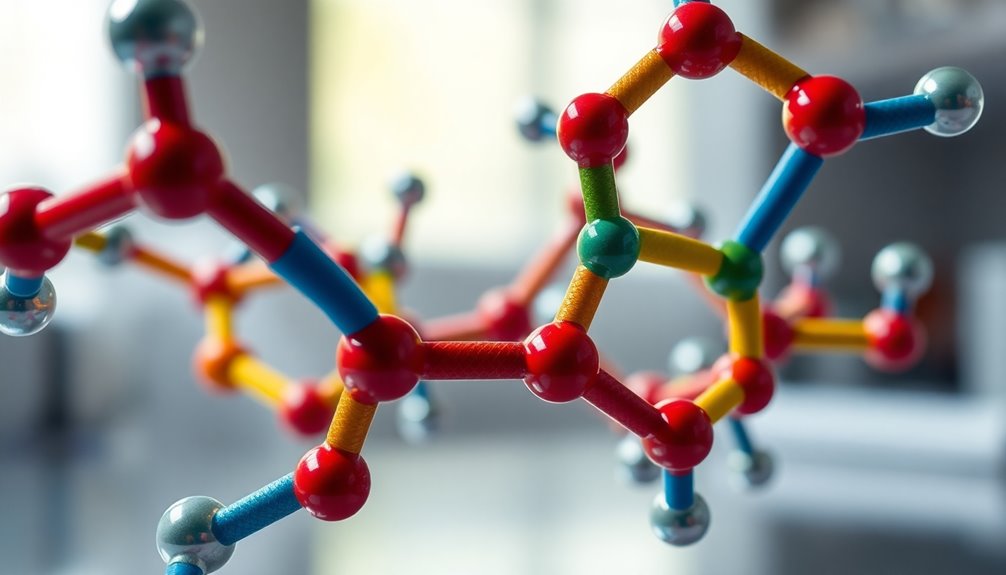
Understanding the role of aromatic bonds in organic chemistry is fundamental, as they greatly influence the behavior and reactivity of compounds. Aromaticity, defined by Hückel's rule, requires 4n + 2 π electrons, providing stability to cyclic compounds. This stability leads to unique substitution reactions, unlike the addition reactions typical of non-aromatic compounds.
Aromatic compounds are significant in pharmaceuticals due to their enhanced bioactivity, affecting how these molecules interact with biological targets. Their influence extends to the physical properties, including solubility and boiling points, making them essential in molecule design.
| Feature | Aromatic Compounds | Non-Aromatic Compounds |
|---|---|---|
| Stability | High | Low |
| Reactivity Pattern | Substitution | Addition |
| Bioactivity | Enhanced | Limited |
Frequently Asked Questions
What Type of Bonds Are Aromatic?
Aromatic bonds are a unique type of chemical bond found in cyclic compounds.
You'll notice that these bonds involve the sharing of electrons across adjacent carbon atoms, creating a stable structure.
Unlike typical single or double bonds, aromatic bonds result from delocalized π electrons, leading to equal bond lengths.
This delocalization contributes to the stability and lower reactivity of aromatic compounds, making them quite distinct in the world of chemistry.
What Is an Example of an Aromatic Compound?
When you think of aromatic compounds, you might consider benzene, toluene, or naphthalene.
Benzene, with its planar hexagonal structure and resonance, is a classic example. Toluene, a methyl-substituted derivative, serves as an industrial solvent, while naphthalene, known for its mothball use, consists of fused benzene rings.
Each compound showcases unique properties and applications, illustrating the rich diversity within aromatic chemistry.
How to Know if a Compound Is Aromatic?
To determine if a compound is aromatic, check if it's cyclic, planar, and has a closed loop of p orbitals.
You'll also need to apply Hückel's rule, ensuring it has (4n + 2) π electrons, where n is a non-negative integer.
Make sure all p orbitals overlap for full conjugation, as this allows for electron delocalization.
If it doesn't meet these criteria, it's likely non-aromatic or antiaromatic.
Does Aromatic Mean Double Bond?
No, "aromatic" doesn't simply mean a compound has double bonds.
While some aromatic compounds may appear to contain alternating single and double bonds, all the bonds are actually equivalent due to resonance.
Aromaticity involves delocalized π electrons in a cyclic structure, not just the presence of double bonds.
Conclusion
In summary, aromatic bonds play an essential role in organic chemistry, offering unique stability and reactivity. Did you know that over 70% of all pharmaceuticals contain aromatic compounds? This highlights their significance not only in nature but also in everyday products. Understanding these bonds opens up a world of possibilities in research and development. So, whether you're a student or a professional, diving deeper into aromaticity can enhance your grasp of chemistry and its applications.






